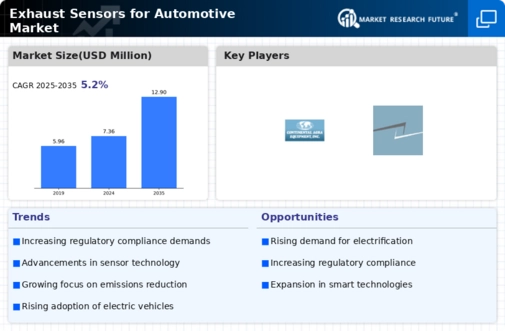Market Trends
Key Emerging Trends in the Automotive Exhaust Sensors Market
In recent years, the automotive industry has witnessed significant advancements in technology, particularly in the realm of exhaust sensors. These sensors play a crucial role in monitoring and controlling emissions from vehicles, thus contributing to environmental sustainability and regulatory compliance. As the automotive market continues to evolve, several key market trends have emerged in the realm of exhaust sensors.
Firstly, there's a growing emphasis on stricter emission regulations worldwide. Governments and regulatory bodies are imposing more stringent emission standards to combat air pollution and address climate change concerns. This regulatory landscape is driving the demand for advanced exhaust sensors that can accurately measure and control emissions in real-time.
Additionally, there's a noticeable shift towards electrification in the automotive industry. With the rise of electric vehicles (EVs) and hybrid electric vehicles (HEVs), the traditional internal combustion engine is facing competition like never before. However, even in the electric vehicle segment, exhaust sensors are essential for monitoring emissions from auxiliary systems such as range extenders or fuel cells.
Moreover, the increasing adoption of connectivity and IoT (Internet of Things) technologies is influencing the market for exhaust sensors. These sensors are now equipped with connectivity features, allowing them to communicate data to onboard vehicle systems or external monitoring platforms. This connectivity enables remote diagnostics, predictive maintenance, and optimization of engine performance, enhancing overall vehicle efficiency.
Furthermore, there's a growing demand for exhaust sensors that can withstand harsh operating conditions. Automotive applications subject sensors to extreme temperatures, vibrations, and chemical exposure. As a result, there's a need for sensors with robust designs and durable materials to ensure reliable performance under challenging environments.
Another notable trend is the integration of exhaust sensors into comprehensive emissions control systems. Manufacturers are developing integrated solutions that combine multiple sensors and control units to provide a holistic approach to emission reduction. These integrated systems offer improved accuracy, efficiency, and ease of implementation for automotive OEMs.
Moreover, advancements in sensor technology, such as the use of nanomaterials and MEMS (Micro-Electro-Mechanical Systems), are driving innovation in the exhaust sensor market. These technologies enable sensors to achieve higher sensitivity, faster response times, and reduced size, paving the way for more compact and efficient exhaust monitoring systems.
Additionally, there's a growing focus on sustainability and environmental consciousness among consumers, which is influencing purchasing decisions in the automotive market. As a result, automakers are under pressure to develop vehicles with lower emissions and higher fuel efficiency. This demand is driving the integration of advanced exhaust sensor technologies into new vehicle models to meet eco-friendly standards and appeal to environmentally-conscious consumers.
In conclusion, the market for exhaust sensors in the automotive industry is witnessing several notable trends driven by regulatory requirements, technological advancements, and shifting consumer preferences. As the automotive landscape continues to evolve, exhaust sensors will play a crucial role in ensuring vehicle emissions compliance, enhancing efficiency, and supporting the transition towards cleaner and more sustainable transportation solutions.





Leave a Comment